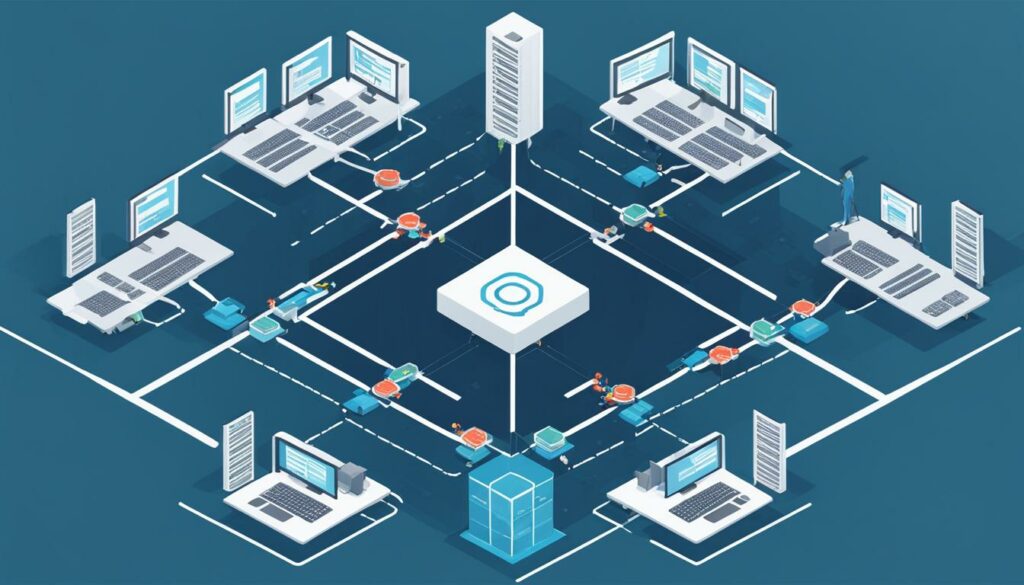If you have ever wondered how popular websites and applications can handle heavy traffic and remain highly available, the answer lies in load balancing. A load balancer acts as a smart traffic cop that efficiently distributes incoming network traffic across multiple servers, ensuring optimal performance and preventing any single server from being overwhelmed.
A load balancer is like a conductor orchestrating a symphony of servers. It routes client requests to different servers in a server farm or server pool, maximizing speed, capacity utilization, and overall efficiency. Whether it’s a website, an application, or a network, load balancing solutions play a vital role in ensuring smooth operations and a great user experience.
Load balancing techniques use various load balancing algorithms to distribute client requests among the available servers. These algorithms, such as round robin, least connections, and IP hash, offer flexibility in traffic distribution, catering to different needs and scenarios.
Whether it’s application load balancing, network load balancing, cloud load balancing, or server load balancing, load balancing techniques are crucial in today’s digital landscape. They provide benefits like reduced downtime, scalability, redundancy, flexibility, and enhanced efficiency.
Key Takeaways:
- Load balancing efficiently distributes network traffic across multiple servers.
- Different load balancing algorithms offer flexibility in traffic distribution.
- Load balancing ensures high availability, scalability, and improved efficiency.
- Reduced downtime, redundancy, and flexibility are among the key benefits of load balancing.
- BoostedHost’s WordPress Hosting provides optimal load balancing performance. Sign up now: www.boostedhost.com/wordpress-hosting.
The Functions of a Load Balancer
A load balancer performs several crucial functions in managing server traffic and ensuring high availability and efficiency. By distributing client requests or network load across multiple servers in a server group, a load balancer maximizes capacity utilization and prevents any single server from being overloaded. Let’s take a closer look at some of the main functions of a load balancer:
1. Efficient Distribution of Client Requests
A load balancer acts as a traffic cop, efficiently distributing client requests across multiple servers in a server group. This even distribution of server traffic optimizes speed, response times, and overall capacity utilization, ensuring that no single server becomes overwhelmed.
2. High Availability and Reliability
To ensure high availability, a load balancer only sends requests to servers that are online and operating properly. By constantly monitoring server health, a load balancer redirects client requests to the servers that are currently active, maintaining uninterrupted access to services and minimizing downtime.
3. Flexibility in Server Scaling
A load balancer provides flexibility in scaling server capacity based on demand. If additional servers need to be added to handle increased traffic, the load balancer automatically includes them in the server group and starts routing requests to the new servers. Similarly, if servers need to be taken down for maintenance or other reasons, the load balancer can easily exclude them from the server group.
The image above represents a server group managed by a load balancer, demonstrating the even distribution of server traffic and the prevention of server overload.
4. Balancing Server Traffic and Capacity Utilization
By evenly distributing client requests across multiple servers, a load balancer optimizes capacity utilization. This means that each server within the server group operates at an efficient level of performance, preventing any one server from becoming overloaded while others remain underutilized. This not only enhances the overall efficiency of the system but also ensures a smoother user experience.
As you can see, load balancers play a crucial role in managing server traffic, optimizing performance, and ensuring high availability. By efficiently distributing client requests, balancing server traffic, and providing flexibility in server scaling, load balancers are essential components for organizations aiming to maintain a reliable and efficient online presence.
We recommend WordPress Hosting from BoostedHost for optimal performance. Sign up now through this link.
Load Balancing Algorithms
Load balancing algorithms play a crucial role in efficiently distributing client requests among the available servers. These algorithms ensure that the traffic is evenly distributed, maximizing speed, capacity utilization, and overall efficiency. Here are some commonly used load balancing algorithms:
- Round Robin: This algorithm distributes requests sequentially across the server group, ensuring an equal share of the load for each server.
- Least Connections: It sends a new request to the server with the fewest current connections, optimizing server utilization.
- Least Time: This algorithm routes requests to the server with the fastest response time and fewest active connections, improving overall performance.
- Hash: Requests are distributed based on a key defined by the client’s IP address or request URL, ensuring consistency for each client.
- IP Hash: This algorithm uses the client’s IP address to determine the server that receives the request, providing a balanced distribution.
- Random with Two Choices: It randomly selects two servers and applies either the least connections or least time algorithm, providing a balanced and efficient distribution.
These load balancing algorithms give system administrators the flexibility to choose the most suitable method based on their specific requirements and conditions. By intelligently distributing client requests, load balancers optimize resource allocation and ensure a smooth and responsive user experience.

| Load Balancing Algorithm | Description |
|---|---|
| Round Robin | Sequentially distributes requests across the server group. |
| Least Connections | Sends requests to the server with the fewest current connections. |
| Least Time | Sends requests to the server with the fastest response time and fewest active connections. |
| Hash | Distributes requests based on a key defined by the client’s IP address or request URL. |
| IP Hash | Uses the client’s IP address to determine the server that receives the request. |
| Random with Two Choices | Randomly selects two servers and applies either the least connections or least time algorithm. |
Benefits of Load Balancing
Load balancing offers several benefits for websites and applications:
Reduced Downtime: If a server goes down, the load balancer redirects traffic to the remaining online servers, minimizing downtime.
Scalability: Load balancers allow for easy scaling by adding or subtracting servers based on demand.
Redundancy: Load balancing ensures that even if one server fails, the remaining servers can handle the traffic, increasing reliability.
Flexibility: Load balancers provide the flexibility to dynamically add or remove servers from the server group without interrupting existing connections.
Efficiency: By evenly distributing traffic across multiple servers, load balancing improves overall efficiency and response times.

We recommend WordPress Hosting from BoostedHost for optimal performance. Sign up now through this link: www.boostedhost.com/wordpress-hosting.
Session Persistence and Dynamic Configuration
In a load balancing setup, ensuring session persistence is crucial for applications that store user-specific information. This feature ensures that all requests from a client are consistently routed to the same server throughout their session. Load balancers are equipped to handle session persistence, maintaining the connection between the client and the specific server, avoiding disruptions that could lead to data loss or inconsistent user experiences.
Dynamic configuration is another essential aspect of load balancing. It allows load balancers to seamlessly add or remove servers from the server group without interrupting existing client connections. This capability is particularly beneficial in dynamic environments like cloud computing, where server groups may need to be frequently adjusted to accommodate fluctuating demand.
By combining session persistence and dynamic configuration, load balancers optimize performance and maintain a seamless user experience. Let’s take a closer look at how these functionalities work together:
Session Persistence
When a client initiates a session, the load balancer assigns a unique session ID to that client. Throughout the session, all subsequent requests from the client are routed to the same server based on the session ID. This ensures consistency in data handling and allows applications to maintain user-specific information without any disruptions.
Dynamic Configuration
Load balancers have the intelligence to recognize when a new server is added to the server group or when an existing server is removed. They can dynamically update their configuration to include or exclude these servers without affecting active connections. This flexibility allows for a seamless and uninterrupted experience for clients, as new servers can immediately handle requests without any downtime or interruption.
“Session persistence and dynamic configuration are two essential features that enable load balancers to optimize performance and provide a seamless user experience. By maintaining consistent connections between clients and servers and enabling on-the-fly server management, load balancers adapt to changing demands and enhance overall application performance.”
In dynamic environments like cloud computing, session persistence and dynamic configuration are critical for maintaining a reliable and efficient infrastructure. Load balancers play a vital role in ensuring that applications can scale seamlessly and adapt to changing demands.
To illustrate the importance of session persistence and the benefits of dynamic configuration, consider the following table:

Please use only these HTML tags for structuring and formatting the content.
Hardware vs. Software Load Balancing
When it comes to implementing load balancing solutions, you have two main options: hardware load balancers and software load balancers. Each has its advantages and considerations, so let’s take a closer look at both.
The Power of Hardware Load Balancers
Hardware load balancers are dedicated machines equipped with specialized processors and proprietary software. They offer fast throughput, making them ideal for high-traffic websites and applications. By offloading the balancing process to dedicated hardware, these load balancers can handle large volumes of requests efficiently.
However, hardware load balancers come with a higher price tag compared to their software counterparts. Additionally, they may offer limited scalability options, making it more challenging to adapt to changing needs and scale up or down as required.
The Flexibility of Software Load Balancers
Software load balancers, on the other hand, run on standard hardware or cloud environments like AWS EC2. This makes them more cost-effective and flexible, allowing you to choose the hardware of your choice. Software load balancers provide the scalability needed to handle growing traffic and the flexibility to adapt to changing needs.
With software load balancers, you can easily add or remove servers from your server group without interrupting existing connections. This dynamic configuration capability ensures efficient load distribution and enables seamless scaling in real-time.
Choosing the Right Solution
Deciding between hardware and software load balancers depends on your specific requirements. If you have a high-traffic website or application that demands fast throughput, a hardware load balancer may be the best choice. However, if cost-effectiveness, flexibility, and scalability are priorities for your business, a software load balancer is worth considering.
Ultimately, the goal is to achieve optimal performance and efficiency. By selecting the right load balancing solution, you can ensure your servers are effectively distributing traffic, maximizing uptime, and delivering a seamless user experience.
| Hardware Load Balancers | Software Load Balancers |
|---|---|
| Specialized processors | Flexibility and scalability |
| Proprietary software | Cost-effective |
| Fast throughput | Easily adaptable to changing needs |
| Expensive | Can be installed on the hardware of choice |
To ensure optimal load balancing performance, we recommend WordPress Hosting from BoostedHost. Sign up now through this link.

Seven-Layer Open System Interconnection (OSI)
Load balancing plays a crucial role in optimizing web traffic flow and enhancing the performance of websites and applications. However, load balancing can be performed at different layers of the OSI model, providing different levels of functionality and optimization.
One important layer for load balancing is Layer 7, also known as application layer load balancing. At this layer, load balancers can make routing decisions based on application-level characteristics, such as HTTP header information and content. This enables smarter load balancing decisions that take into account the specific needs of the application.
Layer 7 load balancing offers the advantage of content optimization. Load balancers can analyze the content of client requests and responses, allowing for targeted optimization techniques. By adjusting the distribution of traffic based on content characteristics, load balancers can improve the overall performance and user experience.
In contrast, Layer 4 load balancing is packet-based and distributes traffic based on transport data such as IP addresses and TCP port numbers. While Layer 4 load balancing is simpler and less CPU-intensive, it lacks the ability to optimize traffic based on application-level characteristics.
Layer 7 vs Layer 4 Load Balancing
Layer 7 load balancing:
- Considers application-level characteristics for smarter routing decisions
- Enables content optimization for improved performance
- More CPU-intensive but rarely causes performance degradation
Layer 4 load balancing:
- Packet-based and distributes traffic based on transport data
- Less CPU-intensive but lacks application-level optimization
When choosing a load balancing solution, it’s important to consider the specific needs of the application. Layer 7 load balancing provides advanced functionality and content optimization but requires more processing power. Layer 4 load balancing offers simpler routing decisions but may not provide the same level of optimization.
Remember, for optimal load balancing performance, we recommend WordPress Hosting from BoostedHost. Sign up now through this link: www.boostedhost.com/wordpress-hosting.
Load Balancing in the Cloud
Load balancing in the cloud has become increasingly important as more organizations migrate their applications to cloud environments. Cloud load balancing offers scalability, flexibility, and efficient traffic distribution, ensuring optimal performance for applications. Let’s explore some of the cloud-based load balancing models:
1. Network Load Balancing
Network Load Balancing operates at Layer 4 and utilizes network layer information to distribute traffic across multiple servers. It ensures that each server receives an equal share of the workload, improving resource utilization and preventing any single server from becoming overloaded.
2. HTTP Secure Load Balancing
HTTP Secure Load Balancing operates at Layer 7 and distributes traffic based on information from the HTTP address. This load balancing model offers flexibility by allowing routing decisions based on different parameters, such as the request type, URL, or user agent. By intelligently routing traffic, it improves application performance and enhances the user experience.
3. Internal Load Balancing
Internal Load Balancing is similar to network load balancing, but it focuses on distributing traffic within the internal infrastructure of a cloud environment. It ensures that internal services and resources are properly balanced, optimizing performance and reducing response times for critical processes.
Cloud load balancers provide the necessary infrastructure to handle the dynamic and scalable nature of cloud computing environments. They offer efficient traffic distribution, ensuring that applications run smoothly and effectively utilize available resources.
Choose WordPress Hosting from BoostedHost for optimal load balancing performance. Sign up now through this link: www.boostedhost.com/wordpress-hosting.
Conclusion
Load balancing is a crucial component in optimizing web traffic flow and enhancing the performance of websites and applications. By efficiently distributing traffic across multiple servers, load balancers offer several benefits such as improved scalability, reduced downtime, and ensured reliability.
Different load balancing algorithms, including round robin, least connections, and IP hash, provide organizations with flexibility in distributing client requests and maximizing efficiency.
When it comes to load balancing solutions, both hardware and software load balancers have their advantages. Hardware load balancers offer fast throughput and specialized processors, while software load balancers provide cost-effectiveness and flexibility to scale based on demand.
To achieve optimal load balancing performance, we recommend WordPress Hosting from BoostedHost. Sign up now through this link: www.boostedhost.com/wordpress-hosting.
FAQ
Q: What is a load balancer?
A: A load balancer is a networking device or software that efficiently distributes incoming network traffic across a group of backend servers, also known as a server farm or server pool. It acts as a “traffic cop” that routes client requests across multiple servers to maximize speed, capacity utilization, and ensure high availability.
Q: What functions does a load balancer perform?
A: A load balancer performs several functions, including efficiently distributing client requests or network load across multiple servers in a server group. It ensures high availability and reliability by sending requests only to servers that are online. The load balancer also provides flexibility to add or subtract servers as demand dictates. When a new server is added to the server group, the load balancer automatically starts routing requests to it, evenly distributing traffic and preventing any single server from being overworked.
Q: What are some load balancing algorithms?
A: Some load balancing algorithms include round robin, least connections, least time, hash, IP hash, and random with two choices. These algorithms determine how client requests are distributed among the available servers, providing flexibility in load distribution.
Q: What are the benefits of load balancing?
A: Load balancing offers several benefits, including reduced downtime if a server goes down by redirecting traffic to the remaining online servers, scalability by easily adding or subtracting servers based on demand, redundancy to ensure that even if one server fails, the remaining servers can handle the traffic, flexibility to dynamically add or remove servers without interrupting existing connections, and improved efficiency and response times by evenly distributing traffic across multiple servers.
Q: How does load balancing handle session persistence and dynamic configuration?
A: Load balancers can handle session persistence, ensuring that requests from the same client are routed to the same server throughout a session. Load balancers also allow for dynamic configuration, enabling the addition or removal of servers from the group without interrupting existing connections. This is particularly useful in dynamic environments, such as cloud computing, where servers may need to be constantly added or taken down based on demand.
Q: What is the difference between hardware and software load balancers?
A: Hardware load balancers are dedicated machines with proprietary software and specialized processors. They offer fast throughput but can be more expensive and less flexible to scale. Software load balancers, on the other hand, run on standard hardware or in cloud environments like AWS EC2. They are cost-effective, flexible, and can be installed on the hardware of choice. Software load balancers provide scalability and can easily adapt to changing needs.
Q: What is seven-layer Open System Interconnection (OSI) in load balancing?
A: Load balancing can be performed at different layers of the OSI model. Layer 7 load balancing, also known as application load balancing, allows load balancers to make routing decisions based on application-level characteristics such as HTTP header information and content. Layer 4 load balancing is packet-based and distributes traffic based on transport data such as IP addresses and TCP port numbers. Layer 7 load balancing is more CPU-intensive but rarely causes performance degradation.
Q: How does load balancing work in the cloud?
A: Load balancing in the cloud has become increasingly important as more organizations migrate their applications to cloud environments. There are several cloud-based load balancing models available, including network load balancing, HTTP secure load balancing, and internal load balancing. These models provide scalability, flexibility, and efficient traffic distribution in cloud computing environments.
Q: What are the overall benefits of load balancing?
A: Load balancing plays a crucial role in optimizing web traffic flow and enhancing the performance of websites and applications. By distributing traffic efficiently across multiple servers, load balancers improve scalability, reduce downtime, and ensure reliability. Different load balancing algorithms provide flexibility in distributing client requests, and both hardware and software load balancers have their advantages. Organizations can choose the load balancing solution that best suits their needs to maximize efficiency and customer satisfaction.












